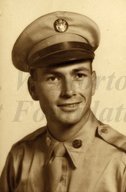
|

|
|
|
|
Roy was born at home in Kilgore, Texas, to John Roy Camp and Johnnie Mae Rice Camp. He was the oldest of three brothers, but the household also included his two half-sisters from his father's marriage to his first wife, who was deceased. Although he is a junior, the name "John" is not on his birth certificate. The elder Camp farmed and worked for Kelly Plow Company in Longview, Texas. He later ran a grocery store and service station "on the highway next to the house," Roy recalls. He then became a manager of Phipps & Company, a feed store. Roy and his younger brothers worked at the feed store part-time, helping customers with one hundred-pound feed sacks. "We got in shape pretty good," he says of the work. In addition, he held other jobs as a teenager. He raised peanuts, corns, and peas on the family farm. He worked in a Safeway grocery store as well as at a publishing house as janitor and mail clerk. Too young for service during World War II, he delivered water by truck. Big for his age, Roy recalls soldiers from nearby Camp Fannin seeing him in town on Saturday night and calling him "draft dodger." "I was a big ol' kid. I weighed one hundred and eighty pounds," he says. After graduating from Kilgore High School in 1948 he entered Kilgore College, but dropped out to work for the printing shop at Kilgore News Herald. In 1950 he went to work for Magnolia Petroleum Company in Premont, Texas. On February 3, 1951 he married Jo Ann Sledge. (They would have two children, five grandchildren, and two great-grandchildren.) Roy was drafted and entered the U.S. Army on April 10, 1951. He went through basic training at Camp Chaffee, Arkansas, and was trained in artillery. He completed NCO leadership school, worked as cadre at a training company, and then entered Officers Candidate School (OCS) at Fort Bliss in El Paso, Texas in November of 1951. He was commissioned as a second lieutenant on May 2, 1952, and assigned to a towed 40-mm battery as part of 10th Battalion at Fort Bliss. Soon after commissioning he served as a battery commander. The 10th Battalion was moved to Spokane, Washington, to furnish guns for Fairchild Air Force Base. A month later, receiving overseas orders, he flew to Japan, then boarded a troop ship for Pusan, where he arrived in late December of 1952. Entering 2nd Division, Roy was sent to 82nd AAA Automatic Weapons Battalion north of Yong Chong. He served as an assistant platoon leader of a battery with four fifty-caliber guns, mounted on each of eight half-tracks, and firing indirect fire missions on ground targets. After a brief stay there, he became commander of the other platoon in the battery. The men lived in bunkers with gasoline stoves and built latrines by using land mines to blow a hole in the frozen ground. They received hot food usually every day. In February of 1953 Roy received a letter announcing the birth of his son. "I bought a box of cigars and passed them out," he recalls. In March of 1953 his unit was pulled back off the line to train Korean soldiers and to guard bridges. In May he took seven days of rest and rehabilitation (R&R) in Kokura, Japan. He later moved to the Coch`iwon area in central Korea. His platoon occupied a hill called White Horse, with his CP (command post) beside a French battalion. He enjoyed dining with the French officers, who had tables with white cloths and enlisted men serving. Promoted to first lieutenant in June of 1953, he was made a company commander. The night before the truce was signed his CP came under mortar attack. Near the end of his tour of duty in Korea he served as battalion liaison to division artillery. Roy left Inchon for America in October of 1953 on the USS General R. L. Howze (AP-134), arriving sixteen days later in San Francisco. At Fort Hood, Texas, on November 20, he transferred from active duty into inactive reserves. He returned to Mobil Oil in operations at a gas plant, resuming his career with that company. He retired January 1, 1992. |


